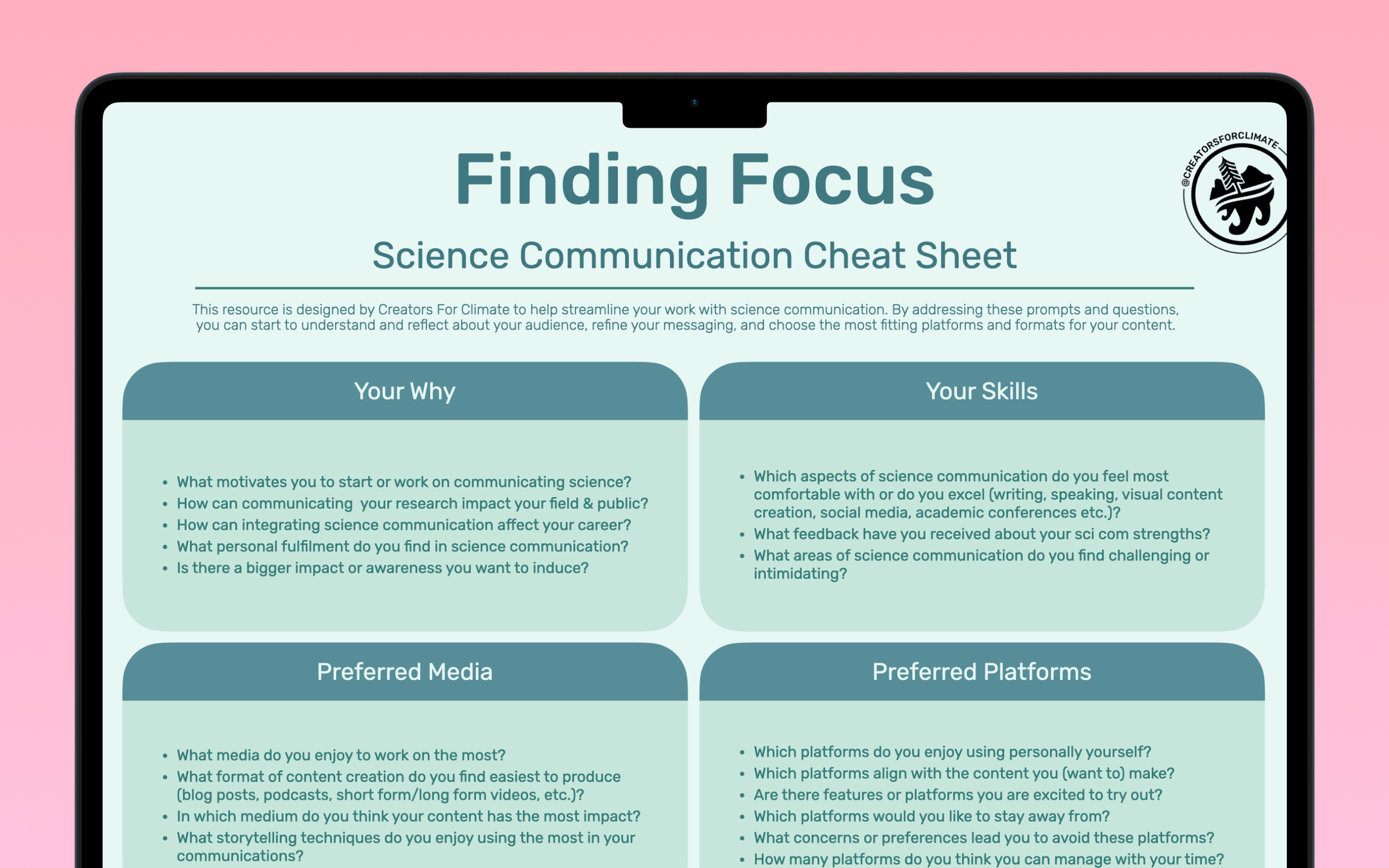Find Focus and build a Personal Brand that connects with your Audience.
What makes those big name creators and science communicators more successful than others? It’s a question I’ve been racking my brain over for the past decade and I decided to do some digging. This blog dives into the key aspects that all these ‘personal brands’ have in common: Focus in their work, knowing their audience in and out and adapting their communication style to fit their audience.
And for that I created a cheat sheet so you can reflect on what that means for your own personal brand, whether you are a creator, science communicator or anything in between. More about that in a bit though, first let’s explore these 3 topics in more detail!
Focusing Your Output
If you don’t ask yourself why you’re creating all of your content, you’re setting yourself up for some head scratching later on when nothing seems to be working. Instead, by knowing your why, you have a heading and can start setting goals for yourself. It also allows you to explore the unique angles that your content can provide, that others can’t.
When we know WHY we do what we do, everything falls into place. When we don’t, we have to push things into place.
- Simon Sinek
There are two main ways creators focus their outputs. And just like every binary system, there can be that grey area in between, where you find creators all over that spectrum.
Idea based creators:
For some this means honing in on a specific niche and work out ideas that all fit together. If you’re an idea-based creator, you focus primarily on the content itself—the topics, concepts, or information you wish to share. The content is often centered around specific, but bigger, themes such as technology, science, education, or any niche subject. The main appeal of this content is the ideas you present rather than the your personal charm or life.
These creators are likely to:
Prioritize depth of knowledge and expertise in their specific field.
Often use research, data, and structured arguments to build their content.
Attract an audience primarily interested in the subject matter itself.
Be seen as authoritative or educational sources in their niche.
Personality-Based Creators
Personality-based creators, on the other hand, draw audiences largely through their character, personal stories, and charisma. If you’re a personality based creator, your content often revolves around your personal experiences, opinions, and everyday life. Even when discussing broader topics, the appeal often lies in your personal take or how you present the material rather than the topic itself.
These creators are likely to:
Build a personal connection with their audience, who often feel like they "know" the creator.
Utilize their unique personality traits, humor, and charisma to engage viewers.
Can cover a wider range of topics, as the unifying thread is their personality.
Often thrive on platforms that prioritize personal interaction, such as vlogs, live streams, and reality-style content.
Both of these types of creators can be successful, but the strategies you use and the audience engagement you receive can differ significantly. Idea-based creators attract those interested in learning or exploring specific topics, while personality-based creators build a community around themselves, attracting viewers who are interested in their personal views and life experiences. Each type appeals to different viewer preferences and behaviors, which influences how you can and should ideate about you content, engage with your audience, and grow your presence online.
All the way below, you’ll find the cheat sheet I promised, but here are already a few questions you’ll explore, to help find your why and focus:
What drives my interest in communicating science or fact-based topics?
Which areas of my research am I most passionate about?
Which parts of my own personality do I want to share with my audience?
Understanding Your Audience
The key ingredient: who are we talking to as creators and communicators? Different audiences have different levels of scientific understanding and engagement preferences. These top communicators we talked about earlier know how to listen to their audience’s feedback and rework their messages accordingly, achieving a deeper connection.
This all starts by clearly identifying who your audience is:
What are their demographics (what are they)?
What are their psychographics (who are they)?
Where do they get their information online and offline?
From who do they get their information?
For us creators focused on science or environmental topics, it's especially important to understand your audience's level of awareness and interest in these issues. Knowing how much they care allows you to choose topics that are most relevant and engaging to them, avoiding subjects that might not connect or could potentially alienate them.
For example, an audience knowledgeable about climate change might appreciate advanced discussions on sustainable technologies or detailed policy analyses, while a broader audience might benefit more from fundamental educational content that raises awareness about environmental challenges.
If this is your first time thinking about a defined audience, instead of trying to reach EVERYONE, this cheat sheet can help you get started with:
Who is my ideal audience?
Who is my actual audience?
How can I reach MY people?
How do their interests and backgrounds influence the content I create?
How complex can you go?
The third part to this holy trifecta. Once we have focus and truly understand our audience, we get to adapt our message to suit the various media & platforms and audience groups we have in mind. Whether it’s adjusting the depth of information for a long form podcast or simplifying a complex scheme for a lay level infographic, knowing how to modify your approach is a super valuable skill to have as a science communicator.
To do this I want you to think about the different scientific background levels your audience groups might have. For instance, when creating for a high school audience, you might use simpler language and more visuals to explain fundamental scientific concepts. The goal is sharing information that is accessible and engaging. On the other hand, communicating with an audience that includes PhD-level individuals requires a different approach.
Understanding this, allows you to adjust the technical language and complexity of your message. Can you get into complex theories or data? Or should you stick with the basics? Again, I have some prompts for you to consider:
What is my audience science literacy level?
Do I have different audiences with different levels?
Which formats and platforms do my audience prefer?
How can I modify my message for different media to maximize impact?
Now you
Take out a notebook and get comfortable. Maybe also schedule out a good half hour and let’s ideate around all these questions!



